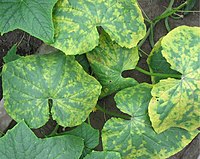
Photo from wikipedia
Cucurbits are among the most important vegetable crops in Iran, growing both in open fields and in greenhouses. They are ranked first in economic value, second in yield, and third… Click to show full abstract
Cucurbits are among the most important vegetable crops in Iran, growing both in open fields and in greenhouses. They are ranked first in economic value, second in yield, and third in acreage and are susceptible to a number of viruses (Bananej and Vahdat 2008). Whitefly-transmitted viruses, namely, cucurbit chlorotic yellows virus (CCYV) and cucumber yellows stunting disorder virus (CYSDV), and the aphid-borne watermelon mosaic virus (WMV), zucchini yellow mosaic virus (ZYMV), papaya ringspot virus (PRSV), and cucurbit aphid-borne yellows virus (CABYV), have all previously been reported from Iran (Bananej and Vahdat 2008; Bananej et al. 2013). During November 2017, 12 samples were collected from cucumber (Cucumis sativus) and 14 from zucchini (Cucurbita pepo) plants grown in open fields that showed virus-like symptoms such as leaf mosaic, mottling, deformation, and yellowing symptoms in Kerman province in the south of Iran. The majority of both plant species were heavily infested by Bemisia tabaci, whereas no aphid colonies were observed. Leaf samples collected from symptomatic plants were subjected to total RNA extraction (Chatzinasiou et al. 2010). Reverse transcription PCR assays used for the detection of CCYV, CYSDV, and CABYV (Orfanidou et al. 2014) showed that all samples were infected with CABYV (26/26), whereas three cucumber samples were infected with CCYV and four with CYSDV. Moreover, double antibody sandwich ELISA was used for detection of WMV, ZYMV, PRSV, and Moroccan watermelon mosaic virus (MWMV) using polyclonal antisera kindly provided by H. Lecoq (INRA, France). None of the samples (0/26) was found to be infected with WMV, ZYMV, or PRSV; however, 9 out of 14 zucchini samples were positive for MWMV infection, whereas none of the 12 cucumber plants were positive for MWMV infection. For further confirmation, the specific primers MoDetF/MoDetR (5′-AARGAYGTTGATGTTGGRAC-3′, 5′-CCATARTCAYTCTTGACYCCATC-3′) were used to amplify a 211-bp product of the capsid protein gene of MWMV. These results confirmed the presence of the virus in the nine zucchini plants. Two isolates were further characterized by sequencing the amplicon, and the BLASTn analysis of the obtained sequences (accession nos. LT985986 and LT985987) showed 100% nucleotide identity with MWMV isolates from Tunisia and Greece (accession nos. EF579955 and LN810061). To our knowledge, this is the first report of MWMV infecting zucchini in Iran. After the detection of the virus in several countries of the Mediterranean region, this report further extends the information on its geographical distribution in the Middle East. The high sequence similarity of the Iranian MWMV isolate with those from the other Mediterranean countries, but not sub-Saharan Africa, indicates their recent rapid spread in the Mediterranean region (Yakoubi et al. 2008). Further surveys should concentrate on the spread, incidence, and epidemiology of this virus in Iran.
Journal Title: Plant disease
Year Published: 2018
Link to full text (if available)
Share on Social Media: Sign Up to like & get
recommendations!